Shortly before Christmas, and before an extended freezing spell that began the day after Christmas, I took the ferry across Upper New York Bay to Staten Island and walked a few miles from the ferry to Clove Lakes Park. I’ll have more on Clove Lakes Park a bit later on in Part 2, but I was keen on walking for some distance on Victory Boulevard — I had walked its western end in Travis in 2006 and again in 2015, but had not walked for any distance on its eastern stretch near the ferry, which has some relics worth noting, and — always worthwhile when doing one of these walks — some unsuspected surprises.

The day was relatively mild (40s) and I went out on the deck for a look aft, as I do almost every time I ride the ferry. Just about everyone else who does this besides me is an out-of-towner, and that’s a shame, because New Yorkers are missing out if they don’t take in this view, especially in fairer weather. There are two large cities visible here, Jersey City and New York, and a former large city, Brooklyn.

The Statue of Liberty recently (2016) celebrated its 130th anniversary in NY Harbor, but the copper colossus was conceived and sculpted by Frédéric Auguste Bartholdi in France in the mid-1870s; Bartholdi finished the torchbearing arm first, and it went on tour to celebrate the American centennial and was displayed in Madison Square Park for several years before it was sent back to France and soldered onto the rest of the work.
Perhaps after being tipped off about the suspicious presence of an unkempt character shuffling about the deck with a camera, the captain may have alerted the Coast Guard about my presence on board. However, the skiff motored away after finding no threat.

Unlike most people who take the ferry across the bay, I neither did a U-turn to take the next boat back to Manhattan or boarded one of the many buses that begin their routes all over the island here. Instead, I walked up the bus depot ramp and straight onto Richmond Terrace, where the first thing you spot is Staten Island Borough Hall. The magnificent John Carrere and Thomas Hastings French Renaissance edifice was completed in 1906. It houses the Borough President’s Office, offices of the Department of Buildings and other civic offices. On the inside, the grand marble lobby contains a series of significant WPA reliefs and murals painted in 1940 by Frederick Charles Stahr, illustrating events in Staten Island history.

Looking across the bay, up until quite recently there was a bangup view of the Shining City beyond the ferry terminal. Beginning in 2017 that view, at least from this vantage point, has been eliminated by a new project, Empire Outlets, which is slated to bring 100 stores and restaurants and a 190-room shorefront hotel along the east side of Richmond Terrace between the ferry landing and the Staten Island Yankees ballpark. The project has been delayed a few times, but is scheduled to pen in late 2018. It was supposed to have been built at the same time as the giant 630-foot New York Wheel, the largest ferris wheel in the world; that project has had numerous delays and was on hold in early 2018. As is, this will be New York’s only outlet store where manufacturers sell wares directly to the public without first selling them to retailers.
Climbing Stuyvesant Place to Hyatt Street, you encounter a memorial statue, depicting a Roman legionnaire, carrying a spear and shield with his right hand stretched out to the north, to Major Clarence Tynan Barrett (1840-1906), a Civil Warrior from Staten Island who served what was in his day the independent county of Richmond in various roles. Barrett, a landscape architect, volunteered for the 175th New York Volunteers regiment at the war’s outbreak in 1862 and served at the Battle of Richmond in 1865. He returned to his architecture business at the war’s end, and also served as police commissioner for seven years. Sherry Edmundson Fry’s bronze was unveiled in 1915, a gift to the city by Barrett’s widow.
You will find a disused fountain and a celebratory inscription on Barrett’s service in the rear of the monument, worn nearly illegible by time on marble, which doesn’t hold up well to weathering.
Rising to the rear of the statue, on the waterfront at Bay Street, is Lighthouse Point, a massive project consisting of a 116-unit apartment tower and a Westin hotel, adjacent to the National Lighthouse Museum.

St. George’s public library at Hyatt Street and Central Avenue (1907) is one of the many institutions built with the aid of a grant by steel industrialist/philanthropist Andrew Carnegie, who funded hundreds of them all over the country in the early 20th Century. The architects were Carrere and Hastings, same as Staten Island’s Borough Hall.
I would have loved to have shown you the interior as well, but the library employees scrambled into action upon seeing my camera, which is as feared as a shotgun or a flamethrower. It was Defcon Three at least. Despite my vociferous protestations they cited their rulebook in preventing interior photography. (The folks in the Tottenville library a few years ago encouraged photography.)

The meticulously restored 1928 St. George Theatre was undergoing some more rehabilitation work on the exterior in 2017. It has attracted some of the bigger names in show business of late for concerts, with 1970s rockers Ace Frehley (KISS), Steve Hackett (Genesis) and America scheduled to appear in early 2018, along with Paul Anka and Dion in separate dates in the spring.
A relatively recent addition to the St. George streetscape is the Staten Island Criminal Court and Supreme Court building (26 Central Avenue, September 2015), the first new courthouse opened in Staten Island in 84 years. While the property was being excavated, a burial ground associated with a 19th-century quarantine hospital was discovered at the site, a former parking lot. A large memorial green containing a single tombstone honoring victims of the Irish famine of 1847-1851 now flanks the new courthouse.
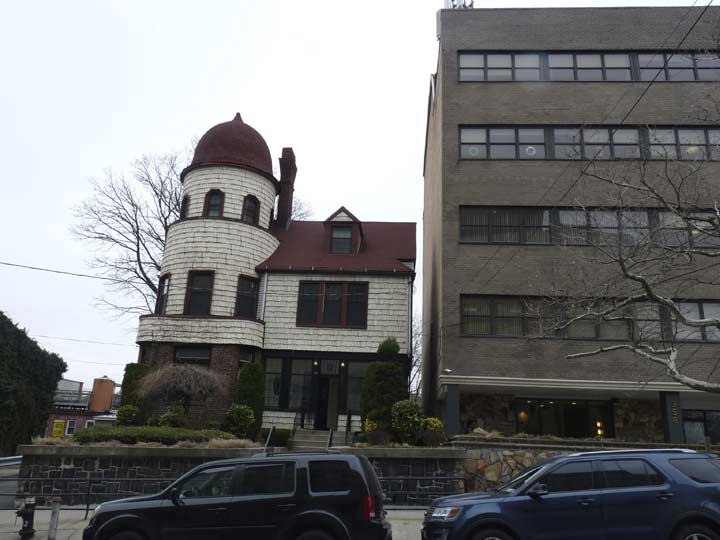
Quite a contrast: on the right is 358 St. Mark’s Place, a 1970s-era office building, and a corner turreted late 19th Century dwelling.
A pair of very old houses on St. Mark’s Place between Hyatt Street and Victory Boulevard. The same street has a collection of homes that are just as aged, but in much better condition, in a neighborhood that deserves, but has not been given, NYC Landmarks Preservation protection further north above Hyatt.

This empty lot on the east side of St. Mark’s, facing Central Avenue, is one of the last remaining in St. George. With the feverish pace of development in these parts, you can expect a condo project or two here, sooner than later.

Seen across Victory Boulevard and St. Mark’s Place is Tompkinsville Park, punctuated by one of NYC’s relatively few Spanish-American War memorials, The Hiker, sculpted by Allen G. Newman, which is a representation of the US troops who walked for miles between battlefields across Cuba. The war (1898) spelled the end of Spanish colonial power in the western hemisphere and set the stage for decades of USA control of territory both in the Caribbean and western Pacific Ocean.

Clustered around Victory Boulevard, Bay Street and St. Mark’s Place is the village of Tompkinsville, founded by a future Vice President, Daniel D. Tompkins (1774-1825) in 1815, while he was the Governor of New York State. He established a ferry service to Manhattan in 1817, from the foot of Victory Boulevard at the bay, and founded the Richmond Turnpike Company as an expedited means for wagons to travel to Philadelphia and elsewhere on the East Coast. Tompkins was elected Vice President on a ticket with James Monroe in 1816, and served two terms. He died here in Tompkinsville just 3 months after leaving office and is buried in St. Mark’s Churchyard on 2nd Avenue and East 10th Street in Manhattan; Tompkins Square Park also bears his name, as well as Tompkins Avenues in Staten Island and Bedford-Stuyvesant, Brooklyn.
Daniel Tompkins’ wife, Hannah Minthorne Tompkins, is also remembered by Tompkinsville’s street layout. Four of his children were named Hannah, Sarah Ann, Griffin and Minthorne. Originally, streets in Tompkinsville bore those four names; today, Van Duzer Street has replaced Sarah Ann Street, Bay Street has replaced Griffin, but Hannah and Minthorne Streets are still in place. Hyatt Street is likely named for Tompkins’ mother, Sarah Ann Hyatt Tompkins, while Minthorne was the name of Tompkins’ father-in-law, Magnet Minthorne. Daniel Van Duzer was a Tompkinsvile landowner in the 1830s, with Van Duzer Street running through what used to be his holdings.
In 1836 Minthorne Tompkins (the son of Vice President Daniel Tompkins) and merchant William Staples established a ferry to Manhattan and founded the village at Bay and Water Streets. German immigrants built numerous breweries in the area in the 1800s including Bachmann, Bechtel, and Piels, whose brewery was in business on Staten Island until 1963. The region south of Tompkinsville took on the name Stapleton in William Staples’ honor. The above map is from 1873 Beers atlas.

 In this 1865 painting by C. Roch, we see Victory Boulevard looking west from Bay Street (known as Griffin and Arietta Streets that year). Daniel Tompkins extended a turnpike west from the street named for his daughter Arietta in 1818 and for a century it was called simply Richmond Turnpike. After the USA’s successful WWI campaign, the turnpike was renamed Victory Boulevard in 1918.
In this 1865 painting by C. Roch, we see Victory Boulevard looking west from Bay Street (known as Griffin and Arietta Streets that year). Daniel Tompkins extended a turnpike west from the street named for his daughter Arietta in 1818 and for a century it was called simply Richmond Turnpike. After the USA’s successful WWI campaign, the turnpike was renamed Victory Boulevard in 1918.
Among the buildings included in the painting: Wiener’s Saloon (foreground right); the Nautilus Hotel (left middle distance); the steeple of the Reformed Protestant Dutch Church (center distance); and the cupola of the Pavilion Hotel (on the hilltop). The figures in the foreground are said to be portraits of well-known Staten Islanders of the 1860s. The couple on horseback in the right foreground are said to be Mr. and Mrs. Tompkins Westervelt, and the man standing at far left is “Fatty” De Nyse, a local saloon keeper. [Historic Richmondtown]

The raised wood letters of the Tompkinsville Pharmacy, St. Mark’s and Victory Boulevard, are unusual by themselves — but about a decade ago, they replaced a sign for one of the last Rexall Drugstores remaining in New York City.

I always wanted to know the story behind the unusual artwork on this 3-story brick building at the NE corner Victory Boulevard and Montgomery Avenue. I may never know since the building may be coming down, or its art is being removed.

Victory Blvd. and Montgomery Avenue meet at an unusual angle, necessitating this parallelogram-shaped brick building on the NW corner.
OK, it’s time for one of my “discoveries” on Victory Boulevard, though local denizens are no doubt quite familiar with it. There’s a set of concrete steps visible next to a laundromat from Victory Boulevard and Monroe Avenue. Not expecting much, I investigated the steps and went up..and up..and up…
…past near breathtaking views of the Narrows and its Bridge and also of the St. George neighborhood…

The staircase is unmarked. Not knowing where I would wind up, I kept climbing on what must be NYC’s longest “step street” besides the also prodigious West 230th Street in Riverdale.

It turns out that this is officially called Pavilion Hill and is one of a series of high hills, in addition to Ward’s, Grymes,’ Emerson and Todt Hills that run across mid-Staten Island. They are as close to mountains as New York city comes.
Two of Staten Island’s main east-west routes run north and south, respectively, of a series of high hills that run through the island like a spine. The hills were left by the passage of a glacier during the last ice age; a similar, though more modest, set of hills can be found in the cemetery belt separating Brooklyn from Queens. Victory Boulevard runs north of the hills, and Richmond Road runs south of them. Both routes are among the oldest in the city and were busy as early as the 1700s.
Some paths running into the hills from Victory Boulevard are step streets, as the grade is much too steep for auto traffic, but some streets such as Fiedler Avenue, Avon Place, Cebra Avenue and Louis Street climb the hills. The steepest graded streets I have ever walked on were in San Francisco, and while these do not rival the city by the bay, you could get back in shape (if you are out of it) just by walking these hills up and down for a few weeks.
Tompkins Circle, at the top of the hill and the staircase, boasts some of Staten Island’s most eclectic architecture.

Most of the steps have these metal studs inserted in the concrete. They were possibly there to grant some sort of traction, but I found them problematic and I had to descend the steps very slowly to avoid tripping on one and cascading down the steps with a symphony of cracking bones. The steps were not vouchsafed a handhold or railing.
A pair of storefronts on Victory Boulevard’s south side west of Monroe Avenue.

Here’s a view of Tompkins Circle homes on Pavilion Hill from Victory Boulevard, pretty much visible only in the cold months.
A surprisingly intact terra cotta lettered exterior of the Tompkinsville Theater on Victory Boulevard and Fremont Street, now home to a screen print shop. The theater opened in 1925 and was renamed the Victory after World War II.

I took a brief detour on Brook Street, which was already in place in 1873 (see map above) in search of some older buildings. This woodframe “saltbox” on Brook and Westervelt Avenue may fill that bill.
The aptly-named Tudor Funeral Home on Victory Boulevard, west of Westervelt. Many funeral homes around town feature very interesting architecture and design, but I know better than to look at their websites for any interesting tidbits. It’s just not done — I’m not supposed to be looking at their websites for that kind of information (many churches also have that philosophy, though some church websites are very helpful.

The press-on lettering on the transom window at #200 Victory Boulevard says” “No littering, no drugs.” One can only hope.
A church with two names on the north side of Victory at Pike Street, the Mt. Sinai United Christian Church and the Staten Island Christian Union Church.
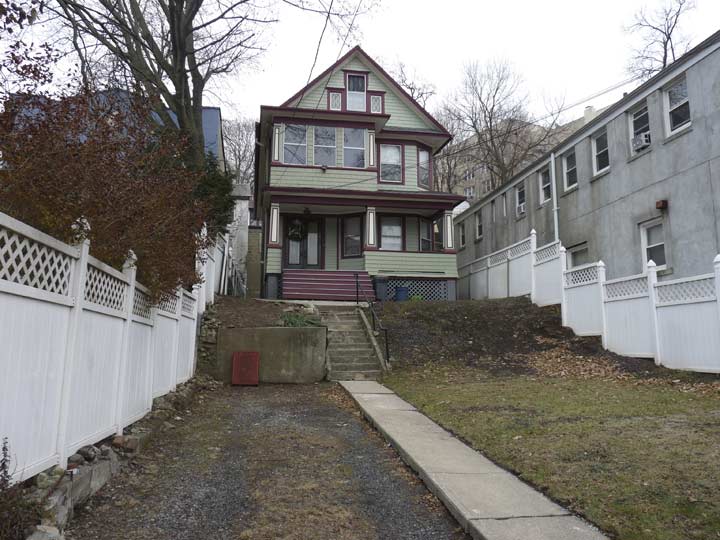
I have always been fascinated with houses set way back from the street, with huge front lawns it must be a lot of trouble to keep mowed. This one has preserved a lot of near-original detail including the doors, the half porch with polygonal bay window behind it, and chamfered corner. And, take a look at the window arrangement in the attic!

At Victory Boulevard and Jersey Street, another set of steep steps climbs up Pavilion Hill. The steps and railings–which are in rather tough shape — are delineated by a stone and wood gateway arch. How long this arrangement has been there is anyone’s guess.
The city doesn’t mark the steps with any signage; I call them the Avon Steps, since they lead up to the steep intersection of Avon Place and Willis Street. Google Maps shows an unnamed pathway here, while my ancient Hagstrom simply shows Avon continuing straight through to Victory Boulevard.

There are certainly collisions on Staten Island, as this auto repair shop on Victory Boulevard proves.

This low-rise woodframe on Victory west of Jersey Street may or may not be ancient, but if it’s not, it was certainly made to appear that way.

Yet another set of steps west of Jersey Street on Victory. The property is still private, but whatever dwelling the steps accessed is gone.

The Albanian Islamic Cultural Center of Staten Island on Victory Blvd. east of Cebra Avenue was in the news in 2016 when Colorado photojournalist Norman Gershman exhibited present-day photographs of aging Albanians who sheltered Jews from the Nazis during World War II. The photos, along with interviews, were the basis of Gershman’s book Besa: Muslims Who Saved Jews in World War II. A curriculum on the subject was also developed at nearby Wagner College. People of Albanian extraction number about 30,000 in Staten Island, a considerable number.

Looking north on Cebra Avenue from Victory Boulevard. This is a major north-south artery running between Castleton and St. Paul’s Avenue, funneling traffic to Beach Stret, which runs into the heart of Stapleton. Cebra Avenue has been on maps since 1873, but I haven’t found a source for the name; possibly a 18th Century landholder. (Strangely, Staten Island also has a Zebra Place, in Rossville.)
There has been something missing from this view since 2012…

…a view of the old Staten Island Hospital, originally the S. R. Smith Infirmary, which had been constructed in 1890 and abandoned since 1979. It was a rare NYC example of Ruskinian Gothic architecture: an extant example is the Jefferson Market Library on 6th Avenue and West 10th Street in Greenwich Village. After nearly a quarter century of abandonment, a developer finally tore it down in 2012, but the grounds remain weed-filled.
Occasionally you see an empty mast on telephone poles along Victory Boulevard and you might be tempted to think that it used to hold old-fashioned incandescent streetlights. Before the 1960s, such masts were there but this isn’t one of those. The masts used to hold traffic signs indicating bus lanes, etc. Guy-wired posts that are generally used to hold stoplights at busy corners have replaced them; this arrangement can also be seen on Woodhaven Boulevard in Queens.
I was curious about this 2-story building with a stone exterior on Victory Boulevard and Austin Place. The thing to do in such a case is to consult a handy dandy Sanborn property atlas from the NYPL. This clears things up, but not all the way. The map was taped together and some of the seams are right on top of the entry. I make out “Storage and van” and “fireproof” which explains the stone exterior.
Our Lady of Good Counsel Roman Catholic Church was founded in 1898, with its original church midblock on Austin Place between Victory Boulevard and Ward Avenue. The current modern structure was dedicated in 1966. For most of its existence, the parish was affiliated with the Augustinian order of priests, who had an academy adjacent to Wagner College for many years (I will touch on that further on in this entry). The Augustinians left because of a lack of vocations; the parish now falls under the jurisdiction of the New York Archdiocese.

At Louis Street we are one block east of Forest Avenue and Silver Lake Park (which I plan to do more about in a later post). This handsome early 20th Century apartment building is named Silver Lake Court.

In fairer weather, the view of the Shining City looking east on Victory Boulevard at Louis Street is transcendent. This spot is in a valley on the north side of Grymes Hill and Manhattan appears to be floating on air on the horizon.
I have always liked Hero Park, set on a steep slope, the foothill area of Grymes Hill, between Victory Boulevard, Howard Avenue and Louis Street. The park opened in 1920 and is
dedicated to 144 Staten Island soldiers who perished in World War I. The small, picturesque park is on land donated by philanthropist Dr. Louis Dreyfus, a wealthy chewing gum manufacturer. In the middle of the park is a large, irregularly-shaped granite boulder, marked by a sign as Sugar Loaf Rock. New tablets list the names of the 144 soldiers. I was happy to see new signs on the rock–the Parks Department World Wide Web entry still lists them as being missing.
In Part 2: up Grymes Hill, Wagner College, Clove Lakes Park
Check out the ForgottenBook, take a look at the gift shop, and as always, “comment…as you see fit.”
1/28/18










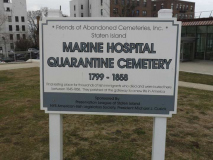













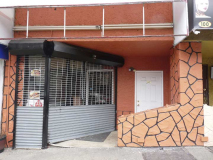
















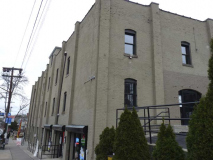

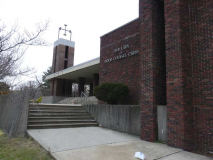





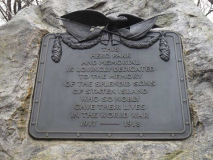





16 comments
Kevin,
Thanks so much for everything you’re sharing with us on this particular series through Staten Island, my hometown.
Yes, commuters generally ignore the views from the ferry since they use it roundtrip about 340 times every year, jammed in with thousands of others. We used to refer to it as “the cattle boat” because during rush hours there were more people than seats and some of us would stand for the 20 minute trip, so you couldn’t see anything over a sea of heads! The only times I remember admiring the views were as a preschool child traveling to Manhattan with my grandmother who would tell me about what the Statue of Liberty meant to her and other immigrants from the 1920s, and later as a young adult traveling home after an evening in “the city” as we Staten Islanders would refer to Manhattan. Its skyscrapers make a truly spendid arrangement of lights after dark, and the view going home by ferry was always memorable.
I look forward to the rest of this series, since I lived near Clove Lakes Park, and attended Wagner College which has an interesting history of its own. One of my art teachers there told our class that — due to those hills you keep mentioning — we had one of the finest views in the world from that campus, spanning from the Verrazano Bridge to Brooklyn to Manhattan surrounding a majestic harbor.
p.s. Forgot to mention, re: the St. George Library — Back in the pre-internet days, when we had to do a project or term paper for grade or high school, often the branch libraries near our homes didn’t have the necessary material. So we’d have to visit that main branch in St. George to use reference materials which couldn’t be checked out or borrowed by other branches. It’s too bad they wouldn’t let you photograph the interior; I’d be glad to see how it’s changed from the times I spent Saturdays there. I’m guessing they were more paranoid about interior photos than other library branches is because they’re located so close to Borough Hall, which would be the logical terrorist target if one were looking to attack Staten Island.
Ditto the interior of the historic St. George Theater; it would be wonderful to see it fully restored.
St. George, a “Regional” library, was Staten Island’s equivalent of the 42nd Street library. It was the only branch where you could check out LP albums; the record collection was a separate room on the second floor. If you didn’t want to tote the disks home, you could listen to them there on headset-equipped turntables.
That wrecked car in front of the Ferry auto body shop was there in the July 2017 Google Street View. Two men are working on the left rear wheel with the hood and trunk lid open. I would imagine they were removing parts, but that begs the question of why the vehicle was still there when you went by almost six months late.
Well, that was an unexpected treat! Reminds me of a 1964 article on NYC in National Geographic that included a stroll up Victory Blvd. A few musings on my part:
The St. George Library has to be the smallest “central” library in the whole NYPL system, and is not central at all (if you live in Tottenville or Travis, it’s quite a hike to St. George). Why the staff wouldn’t let you take photographs is beyond me. A leftover of Mr. Bloomberg’s authoritarian days, I suspect.
My aunt lived at 200 Victory in the early 1980s, and it was as crappy then as it is now (maybe even a bit worse). It looks exactly the same.
The Albanian Islamic Cultural Center used to be a one story Con Ed office, where you could pay your bills and such. After it closed well over 20 years ago, an additional floor was added and it was later turned into the AICC with the addition of the minaret.
Silver Lake Court at Victory and Louis used to be a capital-D dump, with graffiti on the walls and a pile of dead leaves out front 12 months a year. The owners did a nice job of cleaning it up.
Finally, the warehouse-type building at Austin Place was indeed Richmond Storage Warehouse for as long as I can remember, and only was converted to retail space about 15 years ago. Here’s a great picture of that stretch of Victory from 1974 (note the almost-finished WTC (pre-antenna) and the R107 Forest Ave bus, which looks like a GM Fishbowl from about 1962).
http://media.silive.com/memories_column/photo/apr-28-1974jpg-dbe29f8d4fabd76e.jpg
I spent a fair amount of time in the St. George Library in the summer of 1959, between my junior and senior years in high school (Tottenville), doing an extracurricular research project on the early history of Staten Island. The library was very quiet, had more than sufficient material on the subject for my purposes, and the librarian was helpful. I don’t remember what the interior looked like, though, as I am not very observant, so I would have enjoyed seeing your photographs. Too bad they get so hysterical about photography these days! They are robbing the future of visual clues to understanding history!
The view from the hill you described is extraordinary.
The photos that illustrate the bus-only signs above the roadway are a footnote to NYC transit history. In May 1963, the NYC Traffic Commissioner, Henry Barnes, introduced the idea of exclusive curbside lanes for buses only in areas of heavy bus traffic. The first two installations were on Livingston Street in Downtown Brooklyn, and Victory Boulevard between Bay Street and Forest Avenue on Staten Island. As the photos attest, Mr. Barnes’s idea has stood the test of time.
In the 50s, before the Bridge, I used to take the ferry from Manhattan and after walking around St George with a friend sightseeing and lunching, we used to take the 69th Street ferry back to Brooklyn and change for the bus back to our home…..It was always a great day out…Thank You for your great photos again….
The building with the funky artwork on Montgomery was at one time Claude’s West Indian Lounge; the art was added during their tenure. Their signature dish, judging from the only sign on the door, seemed to be curried goat.
Here’s another Staten Island expedition idea for you:
http://www.scoutingny.com/the-godfather-the-new-york-city-filming-locations-then-and-now/
Thank you, I did not see anything of the old Post Office on Bay Street. Is it still there?..
St. George Station is still there inside the Federal Building. That empty area on the corner next to it has finally fallen prey to some kind of new construction.
Thank you so much for this. Staten Island brings back tons of memories for me. I lived there from 1981 to 1992 on Broad Street in Stapleton, St. Paul’s Av, and on Morningstar Road near the Bayonne Bridge.
Those stairs going up from the Victory Blvd.across from Monroe Ave.
name is Pavillion Terrace.They lead up to Pavllion Hill now known as Tompkins Circle
The photos reminded me of scenes in the 1980’s movie “Working Girl”.
I grew up on the block between Our Lady of Good Counsel, and Cebra ave. 1963-1984, I lived in the house directly next to the warehouse, indicated by 388 on your plot drawing. Hero Park was the site of Memorial day ceremonies, and the start of the parade each year. Had that view of Manhatten everyday